The Third Paradise at the MON – Oscar Niemeyer Museum is a project developed to commemorate the 20th anniversary of the museum conceived by the master of Brazilian architecture. Based on an idea by Consuelo Cornelsen, Nadia Calzolari and Giacomo Bassmaji, in collaboration with the Oscar Niemeyer Museum, thanks to its CEO Juliana Vosnika and curator Marc Pottier, Michelangelo Pistoletto’s Third Paradise was chosen as a symbol of cohesion and harmony between people and nature. In the post-pandemic, following a historic time in which people had to keep distances from each other, this work by Michelangelo Pistoletto looks positively at their reunion. The formula 1 + 1 = 3, coined by the artist, strongly and unequivocally describes the importance and strength of collaboration, as two people working together have much more impact than one. The project was divided into three stages and saw the participation of 68 artists from the states of Paranáand São Paulo. The artistic project was curated by Consuelo Cornelsen with the collaboration of Giacomo Bassmaji, Reggio Emilia’s Rebirth/Third Paradise ambassador; Fortunato D’Amico, curator of the Italian artist; and Nadia Calzolari, coordinating the relations between Italy and Brazil.
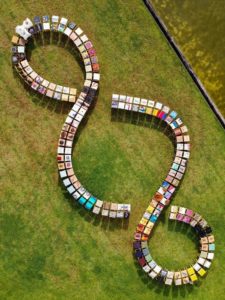
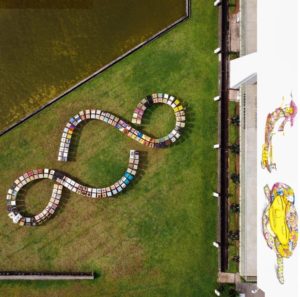
The artists who participated in the project to spread Michelangelo Pistoletto’s message are the following: Abrão Assad, Alberth Diego Murta Ribas, Alejandro Magnere, Alexandre Ruiz e Thais Saboia, Alfi Vivern, Aline Volpato, Ana Penso, André Azevedo, André Mendes, André Nacli, Christian Pentagna, Christian Ullmann, Cleverson Oliveira, Eduardo Bragança, Efigênia Rolim, Eliane Prolik, Emerson Persona, Luiz Pellanda e Aleverson Ecker, Fernanda Castro, Ernando Caldeira de Lacerda, Fernando Canalli, Fernando Velloso, Flávia Itiberê, Maurício Noronha e Rodrigo Brenner, Geraldo Zamproni, Guita Soifer, Hélio Leites, Henrique Hellström, Hugo Mendes, João Sarturi, José Antonio de Lima, Juliane Fuganti, Laura Miranda, Leandro Garcia, Leila Pugnaloni, Leonardo Franco, Leonardo Sokolovicz, Lilian Gassen, Livia Fontana, Lívia Piantavini, Lucas Machado, Luiz Martins, Mano Penalva, Marcelo Conrado, Marcelo Stefanovicz, Max Kampa, Mazé Mendes Nido Campolongo, Nino Cais, Patrick Afornali, Pedro Amin, Pedro Loyola, Pedro Sunyé, Rafael Silveira, Rimon Guimarães, Rodrigo Sasi, Rogerio Ghomes, Ronald Simon, Tatiana Stropp, Tom Lisboa, Toni Graton, Tony Camargo, Verônica Filipak, Vilma Slomp, Washington Silvera.
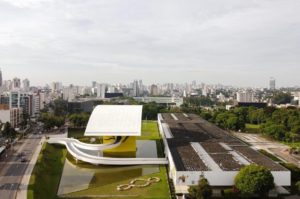
Michelangelo Pistoletto honoured MON with a lectio magistralis in which, in dialogue with Fortunato D’Amico, he retraced all the main stages of his career and work, from his first paintings to the Third Paradise and the Forums he currently holds around the world. He focused on the theme of the mirror paintings, his true artistic revolution, which originated from his study of the “I”, which led him to understand that the artist works for society and people had therefore to be let into his paintings. The theme of trinamics, the dynamic of number three, always represents the birth of a third element between two subjects, either by chance or by intentional combination. Trinamics characterises the processes of union, connection, combination, conjugation, interaction, fusion of two elements that are simple or complex in themselves. The trinamic phenomenon occurs in chemistry and physics, extends to the physiology of bodies and starts to encompass social life in its cultural, political, economic and religious aspects. The trinamic sign-formula, also taken as the symbol of the Third Paradise, draws three aligned circles. The two outer circles represent all opposites, or in fact any duality. The trinamic theorem identifies in the central circle, generated by the conjunction of the two outer circles, a third subject, previously non-existent. Trinamics operates in both the natural and artifcial spheres, including all fields and aspects of human society.
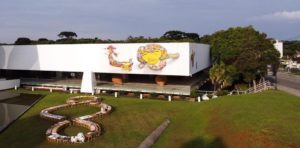
The artists worked on their works for about a month, in continuous dialogue with Consuelo Cornelsen and interacting with the Reggio Emilia embassy. The installation was unveiled on December 1st in an official ceremony at the presence of the General Superintendent of Culture of Paraná, Luciana Casagrande Pereira. The Third Paradise was placed on the wide lawn of MON, next to the famous Eye designed by Oscar Niemeyer. On the day of the presentation, all the artists participated in the performance of placing the canvases on wooden easels. The event attracted a large audience that wanted to honour the Italian artist. The last phase of the project took place at the end of January 2023, when the artists participated in the Curitiba Forum, a collaborative event with the participation of Giacomo Bassmaji and Nadia Calzolari, who involved the attendees through the Demopractic Method, the first reference for the method initiated by Cittadellarte, useful for defining the main areas of action, in connection with territorial needs. The Demopractic Method is divided into three operational phases: Mapping, Forum, Working Site. The process is coordinated by the Rebirth/Third Paradise embassies, independent entities that make up an international network linked to Cittadellarte – Fondazione Pistoletto. The Forum, held at the museum, featured conferences with artists, architects, designers, intellectuals, children and schools working on global emergencies in the area of sustainable development in accordance with the 17 points dictated by the United Nations and summarized in the 2030 Agenda.
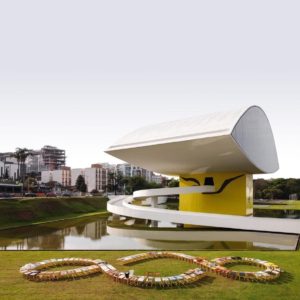
We organized two days of involvement, both starting with a frontal lecture followed by a moment of dialogue between people divided into groups, with a final presentation made by each group leader to summarise the reasoning and ideas discussed earlier. During the day, participants talked about how art can be part of the process of transforming society. Fernando Canalli, an architect, proposed holding a monthly meeting in the form of an artistic presentation on Curitiba, to work together on proposals for the transformation of the city. On the third day, we worked with a group of children and their families together with designer Christian Ullmann on the concept of 1+1=3 using drawing as a learning method, focusing on the concept of sharing and group work as a way for individuals to challenge themselves, exchange ideas and open a dialogue with others. The process of the Curitiba Forum will continue among the people who participated, the artists who learnt to work together and exchange ideas, and all the men and women who collaborated in this important collective work, in their families and in society to generate change in people and to strive for peace and harmony with nature.
Giacomo Bassmaji
Click here to view the catalogue.

